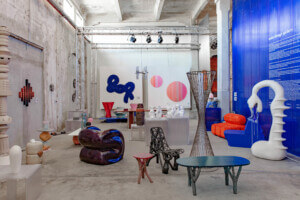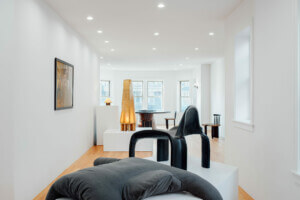After founding their architecture firm, LOT, in 2012, Eleni Petaloti and Leonidas Trampoukis decided to expand into furnishings with their design company, objects of common interest. Based in New York, where they live, and Greece, where they grew up, the multidisciplinary studio has gained a solid following in the design community with its focus on materiality and simplicity.
The Architect’s Newspaper: With LOT, you have built several notable pavilions and interiors projects, like the restaurant Nolita in Athens. What was the impetus behind launching objects of common interest. as an extension of your architectural practice?
Eleni Petaloti and Leonidas Trampoukis: Contrary to creating objects for our architecture and interior projects, objects of common interest. started purely as an expression of ideas, scribbling and sketching, wanting to materialize pieces for our pleasure. Of course, we design custom elements and furniture for our projects, but objects of common interest is not this, as abstract ideas may or may not necessarily lead to a similar aesthetic or conceptual direction. We see objects of common interest. as a sibling studio of LOT. It is run by the same people (us and our associates: Vincent Meyer Madaus in New York and Anastasia Maggouta in Greece) with the intention of creating unique pieces and still-life installations, as well as to establish interdisciplinary collaborations and to move freely between design, art, and architecture.
Many emerging practices today consider the design of objects more and more in their work. What do you think has spurred this fascination with the smaller scale for architects?
Architects have historically been involved, and very good at, working with the small scale in our opinion. We see from a different point of view than a trained product designer: that of an expression rather than for production.
With the emergence of pop-up culture, designers and architects are blending their scope and scales of intervention, leading to very interesting project initiatives for installations, pavilions, pop-ups, etc.
On top of this, other industries work in much faster rhythms and aim toward the creation of architectural environments—where architects who are interested in the smaller scale find ground for experimentation.
You have talked about your design process as having a particular “consciousness” and “pragmatism” that is expressed in a variety of spatial and material ways. Could you elaborate on this?
We think it would mostly direct the conversation to objects that are delicate in materiality, form, or structure, but are there to actually be used and are not “do not touch” pieces.
The marble-and-acrylic Side Tables, for example, are a set of two tables, varied in size, that are comprised of marble slabs capped and held together by a solid cast piece of translucent acrylic—it’s a play in tectonics and material juxtaposition for a commonplace object.
We like designing blended notions of abstraction and activation, which we translated in a different way at the installation for Flatiron Plaza, a monumental sculptural piece, full of activity and interaction with the public.
How does digital technology advance your designs?
We have been exploring concept through the fabrication techniques used, whether digital or not, to highlight certain qualities that we look for in every object. The concrete-and-copper mirror, for example, is cut with a robotic CNC arm out of a single block of aerated concrete—a very cheap material used for building retaining walls—and then out of solid Greek marble, sculpted by hand by craftsmen from the island of Tinos in Greece to produce something that is almost the same, but so much different.
What’s next for objects of common interest?
We are launching a collaboration with Matter showroom in Soho, and have initiated creative collaborations at the next Design Miami, London Design Festival, and Art-Athina in Athens for spatial design projects. This is where LOT and objects of common interest. may come closer and become one, before they take separate ways again, like someone with a dual identity.










